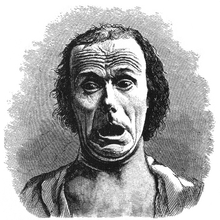Emotion
Emotions are what people feel. They are very ancient, and can be seen in all mammals.
Emotions are caused by a complex mixture of hormones and the unconscious mind. Only with great difficulty can we control our emotions by conscious effort. They cause mammals to change behaviour according to changes in their situation. In our case, they sometimes run against our attempt to live our lives in a logical way.
A scientific definition is not simple; over 90 definitions have been offered by experts.[1] A definition of emotion needs to include three things:
- conscious experience (feelings)
- expressions which can be seen by others
- actions of the body ('physiological arousal')
Here is one definition:
- "Emotion is a complex psychological phenomenon which occurs as animals or people live their lives. Emotions involve physiological arousal, appraisal of the situation, expressive behaviours, and conscious experience. Emotion is associated with feeling, mood, temperament, personality, disposition, and motivation".[2][3]
In physical terms, emotions involve body systems which have operated for hundreds of millions of years. These are the hormone system, the autonomic nervous system and the 'lower' brain centers (hindbrain and midbrain).
Function of emotions[change | change source]

The study of emotions became one of Darwin's books after The Descent of Man. He published The Expression of the Emotions in Man and Animals in 1873. He had discovered, by sending letters and a list of questions worldwide, that in different societies emotions were expressed in almost the same way.[4]
If so, the mechanisms which made the expressions must be inherited. They must have been developed in the same way as all other features of man, evolution by natural selection. It was already known from anatomy that the muscles and nerves of the face were the same or similar in all humans.
Darwin illustrated the expression of the emotions with a series of photographs and woodcut illustrations. Ekman did the same thing on a research visit to New Guinea, where he asked villagers to identify the emotions shown in the photographs.[5] This was part of a long-term effort to test and extend Darwin's insights into emotions.[6][7][8][9] Some of Ekman's conclusions are:[9]
- Micro expressions last only a fraction of a second. They occur when people conceal their feelings. (p15, p222)
- Emotions are autoappraisers, reactions to matters which seem to be very important to our welfare. (p21)
- Emotions often begin so quickly that we are not aware of the processes in our mind which set them off. (p21)
- Autoappraisers scan for events which are critical to our welfare and survival. (p23)
- Our evolutionary heritage makes a major contribution to the shaping of our emotional responses. (p26)
- The desire to experience or not to experience an emotion motivates much of our behaviour. (p217)
- An efficient signal – clear, rapid and universal – informs others of how the emotional person is feeling. (p217)
Animal emotions[change | change source]
It is obvious that some animals, mostly mammals, but also some birds, have emotions which are somewhat similar to human emotions as far as one can tell. The most obvious cases are domestic pets which are clearly happy to see owners after a long separation.[10]
Because two large groups of vertebrates have developed emotions (mammals and birds at least), it must be that emotions are helpful in group behaviour. In a quite different group, social insects, the group behaviour is controlled by pheromones: inherited scent patterns. Scent is also important to most mammals, but birds are more sight-oriented.
Related pages[change | change source]
References[change | change source]
- ↑ Robert Plutchik 2001. The nature of emotions. American Scientist
- ↑ Frijda 1992. The laws of emotions.
- ↑ Myers, David G. 2004. Theories of emotion in Psychology. 7th ed, Worth, New York.
- ↑ Charles Darwin (1873) 1999. The expression of the emotions in man and animals, edited by Paul Ekman. HarperCollins. ISBN 0-00-255866-1
- ↑ Ekman P. 1980. The face of man: expressions of universal emotions in a New Guinea village. New York: Garland.
- ↑ Ekman P. (ed) 1973. Darwin and facial expression: a century of research in review. New York: Academic Press.
- ↑ Ekman P. & Friesen W.P. 1984. Unmasking the face. Palo Alto: Consulting Psychologists Press.
- ↑ Ekman P. & Rosenberg E.L. (eds) 1997. What the face reveals: basic and applied studies of spontaneous expression using the facial action coding system (FACS). Oxford University Press.
- ↑ 9.0 9.1 Ekman P. 2003. Emotions revealed: understanding faces and feelings. London: Weidenfeld & Nicolson. ISBN 978-0-7538-1765-0
- ↑ Oately K. & Jenkins J.M. 1996. Understanding emotions. Blackwell. Malden, MA. ISBN 978-1-55786-495-6


